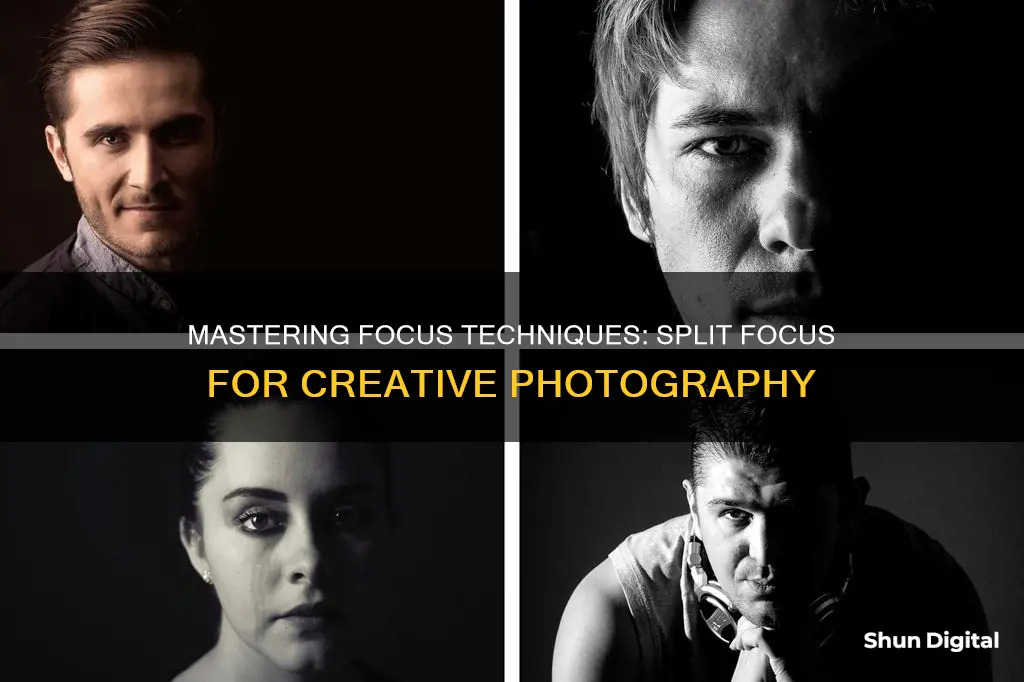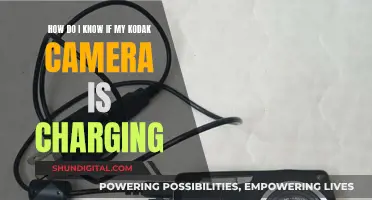
Focusing on multiple subjects in a photograph can be challenging, especially when they are at different distances from the camera. This is where the concept of splitting focus comes into play. In the context of photography, splitting focus refers to techniques that allow photographers to keep multiple subjects in sharp focus within a single frame. This can be achieved through various methods, such as manipulating the depth of field, using a split diopter lens, or employing manual focus techniques found in older SLR cameras.
| Characteristics | Values |
|---|---|
| Definition | A split diopter lens is a piece of half convex glass that attaches to the main lens of the camera. |
| How it works | The lens makes half the lens nearsighted while the other half remains farsighted, creating the illusion of deep focus. |
| Benefits | Provides more information in a single shot, highlights the relationship between two subjects, and creates a sense of uneasiness in the viewer. |
| Use cases | Can be used to convey a certain mood, direct the audience's attention, or reveal insight into characters. |
| Drawbacks | Requires commitment to a particular vision, creates a noticeable line in the frame where the focus planes change, and can be distracting for viewers. |
| Alternatives | Deep depth of field (where everything in the frame is in focus) or shallow depth of field (where only the foreground, middle ground, or background is in focus). |
What You'll Learn

Split-screen and microprism ring focusing in old SLRs
Focusing with a split screen and microprism ring in old SLRs can be a challenging but rewarding experience. The most common type of focusing screen in non-autofocus 35 mm SLR cameras is the split screen and microprism ring, which became standard in the 1980s.
The microprism ring is a useful tool that blurs the image when the lens setting is out of focus. The image will appear sharp and clear when the lens is correctly focused. The split screen, on the other hand, shows part of the image split into two pieces. To achieve focus, you must adjust the lens until both pieces are aligned. This method can be tricky, and it's easy to think you've achieved focus when the pieces aren't quite aligned.
One significant drawback of using the split screen and microprism ring focusing method is the considerable light loss due to the prisms. This makes low-light focusing extremely difficult, if not impossible. Additionally, the system may not work well in low light or with slow lenses, as the focusing aids can darken considerably.
To overcome these challenges, photographers can use the outer ground glass for focusing, although this may not be as accurate as using the split screen and microprism ring together. It's worth noting that focus will be most accurate when using the split screen, followed by the microprism, and then the plain or ground glass.
While autofocus cameras have replaced these focusing screens with simpler screens and AF points, understanding how to use a split screen and microprism ring can be a valuable skill for photographers, especially when working with older manual focus film SLRs.
Paying Bus Camera Tickets: MD Options
You may want to see also

Split diopter lens for filmmakers
A split diopter lens is a powerful tool for filmmakers, allowing them to create eye-popping visuals and convey complex ideas in a single shot. This technique is achieved by attaching a piece of half convex glass to the main lens of the camera, creating a split focus effect. One half of the lens is nearsighted, while the other half is farsighted, resulting in an illusion of deep focus. This effect allows filmmakers to have two subjects at different distances simultaneously in sharp focus within the same frame.
One of the key benefits of using a split diopter lens is its ability to convey multiple pieces of information in a single shot. Instead of cutting back and forth between different subjects, filmmakers can present multiple elements in a single frame, making for more economical storytelling. For example, in the film "Mission: Impossible," a split diopter shot effectively showcases the proximity of Ethan Hunt to danger, heightening the tension of the scene.
The split diopter lens is also useful for revealing insights into characters and their relationships. By using this technique, filmmakers can juxtapose two contrasting characters in the same shot, providing subtle foreshadowing or suggesting a shift in their relationship dynamic. In the film "Carrie," for instance, a split diopter shot places the all-American jock, Tommy, and the social outcast, Carrie, in the same frame, emphasising their connection despite their differences.
Additionally, the split diopter effect can create a sense of uneasiness or strangeness in the viewer. As it diverges from how the human eye naturally perceives depth of field, this technique can be particularly effective in horror and thriller genres to heighten the sense of unnatural tension. A notable example is the film "Jaws," where a split diopter shot showcases Martin Brody's divided attention between a casual conversation and a potential danger in the water.
While the use of split diopter lenses has declined in recent years due to the challenge of committing to a particular vision, it remains a valuable tool for filmmakers seeking to create striking visuals and convey complex narratives in their films.
Charging the Eufy 2C: A Quick Guide to Powering Up
You may want to see also

Split-field diopter: a partial lens attachment
A split-field diopter is a partial lens attachment that can be added to your camera setup to achieve a unique visual effect. It consists of a curved mirror or a piece of half convex glass that attaches to the front of your camera lens, leaving half of the lens space uncovered. This setup splits the shot into two separate planes of focus, allowing you to focus on both near and far subjects simultaneously.
The split-field diopter is a versatile tool that can enhance your visual storytelling. It is particularly useful when you want to create a split-screen effect without relying on post-production editing. It also serves as an alternative to rack focus techniques, allowing you to maintain focus on both foreground and background subjects. Additionally, it can help you achieve the illusion of deep depth of field, even when shooting with a wide aperture.
The diopter is available in different strengths and sizes to accommodate various camera lenses and filter holders. By choosing the appropriate strength, you can precisely control the degree of separation between the near and far subjects in your composition. This allows you to tailor the effect to your creative vision.
One of the main advantages of using a split-field diopter is the ability to create visually captivating shots with multiple planes of focus, adding depth and dimension to your images. However, one potential drawback is the creation of a noticeable line where the focus planes change, which can be distracting for viewers. It requires careful composition and lighting techniques to minimise this effect and ensure a seamless transition between the focused areas.
FLIR Cameras: Where Are They Manufactured?
You may want to see also

Depth of field: the distance/length of objects in focus
Depth of field (DoF) is a crucial concept in photography, which refers to the distance between the nearest and farthest objects that appear acceptably sharp in an image. Essentially, it determines how much of your image is in focus. A deep depth of field means that everything in the frame is in focus, whereas a shallow depth of field means that only the foreground, middle ground, or background is in focus. The transition from sharp to unsharp is gradual, and the term "acceptably sharp" is subjective and depends on factors such as how the image will be viewed and individual vision.
The depth of field can be manipulated by adjusting factors such as aperture, camera-subject distance, and focal length. A larger aperture, or a higher f-stop number, will result in a larger depth of field, with more of the image appearing sharp. Conversely, a smaller aperture or lower f-stop number will create a shallower depth of field, with a more limited area in focus.
The distance between the camera and the subject also impacts the depth of field. A shorter distance between the camera and the subject results in a shallower depth of field, making it more challenging to get the entire subject in focus. By increasing the distance between the camera and the subject, you can achieve a greater depth of field.
Additionally, the focal length of the lens can influence the depth of field. Wide-angle lenses (short focal lengths) generally have a deeper depth of field compared to telephoto lenses (long focal lengths). However, it is important to note that the field of view and camera-subject distance also play a role in determining the depth of field. By adjusting the camera-subject distance to maintain the same magnification of the subject, you can achieve the same depth of field with different focal lengths.
Understanding how to control the depth of field allows photographers to create the desired effect in their images, whether it's a shallow depth of field for creative blur or a larger depth of field to keep everything in focus. Experimenting with different camera settings and lenses is the best way to learn how these factors influence the depth of field and to master this essential technique in photography.
The End of Camera Ticketing: Why the Change?
You may want to see also

Focusing screens: split-image vs autofocus
Focusing screens are a flat translucent material, either ground glass or a Fresnel lens, found in system cameras that allow the user to preview the framed image in a viewfinder. There are three main types of focusing screens: a split circle with a prism collar, a matte focus screen, and a gridded focus screen.
The split circle with a prism collar was the most common type of focusing screen in non-autofocus 35 mm SLR cameras and became standard in the 1980s. The split screen shows part of the image split into two pieces, and when both pieces are aligned, the setting is in focus. However, the prisms cause considerable light loss, making low-light focusing almost impossible. When autofocus was introduced, these focusing screens were replaced with simple screens and AF points.
Matte focus screens are now the norm and are the default in most modern DSLRs. They make things a little darker and easier to judge the depth of field accurately.
Gridded focus screens have a grid pattern that helps the photographer align or position subjects in the composition.
While autofocus has largely replaced the need for manual focus and the split-image focusing screen, some photographers still prefer the control and precision that a manual focus and split-image focusing screen provide. Additionally, some cameras offer the option to replace the focusing screen, allowing photographers to choose the screen that best suits their needs.
Charging Vintage Camera Gear: 1990s Battery Revival
You may want to see also
Frequently asked questions
A split diopter lens is a piece of half convex glass that attaches to the main lens of the camera. This makes half the lens nearsighted while the other half remains farsighted, creating the illusion of deep focus.
A split-field diopter is a partial lens that you attach to the front of your camera lens. It allows a shot to have two planes of focus, with the foreground and background both appearing equally clear.
With a deep depth of field, everything in the frame is in focus. With a shallow depth of field, only the foreground, middle ground, or background is in focus while everything else is not.
The microprism ring blurs the image unless the lens setting is in focus. The split screen shows part of the image split into two pieces. When both pieces are aligned, the setting is in focus.







